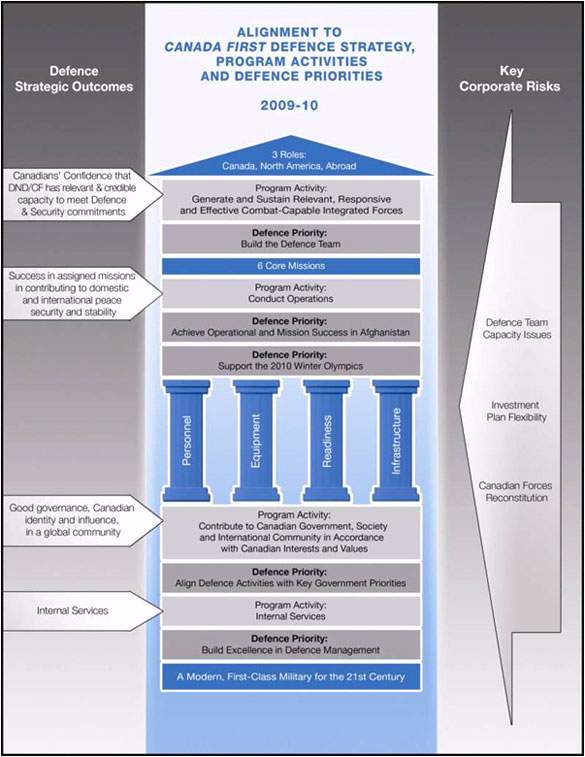Common menu bar links
Breadcrumb Trail
ARCHIVED - National Defence - Report
 This page has been archived.
This page has been archived.
Archived Content
Information identified as archived on the Web is for reference, research or recordkeeping purposes. It has not been altered or updated after the date of archiving. Web pages that are archived on the Web are not subject to the Government of Canada Web Standards. As per the Communications Policy of the Government of Canada, you can request alternate formats on the "Contact Us" page.
MINISTER'S MESSAGE
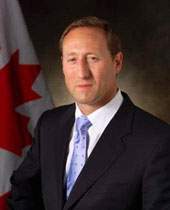
As Minister of National Defence, I am pleased to present to Parliament and Canadians the 2009-10 Departmental Performance Report for the Department of National Defence and the Canadian Forces (DND/CF) 1. Defence's mandate is diverse and complex, and the operational tempo of the last year has been very demanding and one of the highest in recent memory. As a core member of Canada's whole-of-government team, the men and women of the CF and the civilian members of the Defence Team have worked with our partners to address a large variety of domestic and international security challenges including in Afghanistan and Haiti, as well as here at home. This report highlights progress made during the last fiscal year towards achieving our strategic goals and Defence Priorities.
Domestically, the CF delivered excellence at home by: conducting numerous Search and Rescue missions to help Canadians in distress; supporting the RCMP in providing security for the 2010 Winter Olympic and Paralympic Games in Vancouver. In addition, the CF continued to help implement the Government of Canada’s Northern Strategy by exercising sovereignty, demonstrating presence and providing support to other government departments and agencies in Canada’s North.
In the continental context, the CF remained a strong and reliable defence partner in North America, conducting daily continental operations and ensuring control of our airspace through NORAD. Defence also contributed to the security pillar of the Government's Americas Strategy in the Western Hemisphere by, notably, supporting multinational security efforts for the 5th Summit of the Americas in Trinidad and Tobago this past April.
Internationally, Afghanistan continued to be a significant focus of CF efforts, which included training the Afghan Army and Police as well as providing increased security for governance, reconstruction and development efforts in Kandahar. In addition, the CF projected leadership abroad by joining coalition partners in conducting counter-piracy and counter-terrorism operations in the Gulf of Aden, the Gulf of Oman and the Arabian and Red Seas. The quick deployment of CF personnel to Haiti to provide relief in the aftermath of the tragic earthquake this past January also demonstrated the capacity of our military to meet defence and security commitments abroad. At peak, the maritime, land and air components of Joint Task Force Headquarters comprised about 2,050 personnel divided between Port-au-Prince, L�og�ne and Jacmel.
This reporting period was also marked by an economic climate which, more than ever, demands excellence in Defence management. While the Department witnessed a budget increase, it was necessary to implement measures in order to manage effectively and spend responsibly. In conformity with the Government's Management Accountability Framework, Defence consolidated, strengthened, and undertook new measures and approaches to ensure continuous improvements throughout all levels of management. These efforts helped lay the groundwork for the Strategic Review, which was announced in Budget 2010.
The implementation of the Canada First Defence Strategy (CFDS) - a plan to rebuild the CF through balanced investments across the four pillars of personnel, equipment, readiness, and infrastructure - has contributed to Canada's economic growth. For example, Defence announced a total of $1.8 billion in infrastructure projects, which contributed to the creation of an estimated 4,320 jobs across Canada and supported the Government's overall efforts to strengthen the Canadian economy. At the same time, investments in this pillar are part of the CFDS goal of replacing or refurbishing the Defence infrastructure portfolio.
Procurement projects, such as the contract awarded for 15 new Chinook helicopters, contribute to a first-class, modern, and flexible military, while benefiting the economy in regions across the country. The Industrial and Regional Benefits Policy requires winning contractors to undertake business activities in Canada at 100% of the total contract value. Defence investments of this kind support Canadian industry and create sustained long-term employment for Canadians.
None of these activities would be possible without investment in Defence's most important resource: its people. Significant progress was made in providing support to ill and injured CF personnel, veterans, and their families. We place tremendous importance on supporting the families of those who have made the ultimate sacrifice for Canada since the beginning of the Afghanistan mission. We recognize those who have lost their lives - 143 by the end of the reporting period, and 152 as of August 30th, 2010. Retention and recruitment strategies have been undergoing revitalization, resulting in the successful recruitment of 7,522 Regular Force personnel, as well as a stabilization of attrition levels. Indeed, the CF is approaching the force expansion goals outlined in the CFDS ahead of schedule.
To defend Canada, Defence relies on the dedication and commitment of our integrated Defence Team and we recognize the essential contribution of the civilian members. A number of measures were undertaken in fiscal year 2009-10 to continue building the Defence Team and create and maintain a workplace of choice. For example, Defence contributed to the overall success of Public Service Renewal initiatives by, among others, improving efficiencies in staffing, implementing a new online self-service system to access pension and pay information, and by consolidating partnerships with universities and community organizations to build a stronger Public Service for the future. Our efforts to recruit civilian personnel to support the CF mission resulted in the hiring of over 235 recent graduates from post-secondary education institutions, as well as the placement of hundreds of Canadians into apprenticeship and professional development programs.
I'm proud to lead this institution and I look forward to continuing collaboration with Canadians and Parliamentarians to further strengthen the Department and the CF and to provide unfailing support to our courageous men and women in uniform. Together, our efforts and the investments in personnel, equipment, and infrastructure have increased the CF's overall readiness and flexibility, allowing our military to fulfill the vital roles and missions outlined in CFDS.
You are invited to learn more about Defence by reading this performance report, as well as by exploring our website at: http://www.forces.gc.ca/site/index.asp.
The Honourable Peter MacKay, P.C., M.P.
Minister of National Defence
SECTION I: DEPARTMENTAL OVERVIEW
Introduction
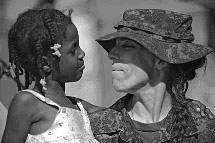
Captain Lyne Poirier of 5 Canadian
Mechanized Brigade Group holds an
orphaned girl in the aftermath of the
earthquake in Haiti.
Photo: Sergeant Bruno Turcotte,
Canadian Forces Combat Camera
Defence articulated a commitment to Sovereignty, Security and Serving Canada in the Report on Plans and Priorities (RPP) 2009-10. The key focus areas highlighted in this report address the activities we undertook, the challenges we faced, and the results we achieved, in meeting that commitment.
-
Ensuring success in domestic, continental and international operations. Defence delivered excellence at home by, among other things, conducting numerous Search and Rescue missions to help Canadians in distress; supporting the Royal Canadian Mounted Police (RCMP) to provide security for the 2010 Winter Olympic and Paralympic Games in Vancouver; and demonstrating sovereignty in the Arctic. We worked with our continental partner, the United States (US), to conduct daily operations and we ensured the control of our airspace through the North American Aerospace Defense Command (NORAD). We continued to project a leadership role abroad and in doing so, contributed to international peace and security. We joined our coalition partners in conducting counter-piracy operations in the Gulf of Aden, the Gulf of Oman, the Arabian Sea, and the Red Sea. Our readiness was evidenced in the rapid deployment of resources to Operation HESTIA, where we provided relief to the Haitian people in the aftermath of the devastating earthquake in January 2010. Throughout a reporting period defined by both large-scale planned and unforeseen activities, we continued to support the Government's ongoing objectives in Afghanistan by training the Afghan Army through side-by-side participation in combat operations, and by providing increased security for reconstruction and development efforts in the Kandahar region.
-
Implementing the Canada First Defence Strategy. During the reporting period, Defence met the level of ambition set out by the Government in the Canada First Defence Strategy (CFDS). We carried out activities related to all six different missions outlined in the CFDS, often simultaneously.
Defence also advanced the long-term strategy to re-build the Canadian Forces across the four pillars of military capabilities - personnel, equipment, readiness and infrastructure. Through the expert leadership, professionalism and sheer dedication of an integrated, motivated and effective Defence Team comprising Regular and Reserve Force members as well as civilians, we increased the number of our personnel, advanced the acquisition and modernization of much needed equipment, and made important investments in science and technology, readiness and infrastructure in support of growing capabilities.
-
Caring for our people. Defence encountered the same demographic pressures as the rest of the public and private sectors during the reporting period. A significant number of military and civilian personnel have retired and will continue to retire over the next decade. Defence successfully managed personnel capacity constraints while delivering trained forces for operational missions, implementing the CFDS, and addressing the challenges of recruiting Canadians to fill shortages in military and civilian occupations. Caring for the ill and injured members of the Regular and Reserve Forces and their families has been a priority for the Chief of the Defence Staff. To that end, we developed better care and support services for CF members and their families by establishing Integrated Personnel Support Centres (IPSC) in regions across the country. These units have provided critical support to members and their families to help them cope with both injuries sustained through operations and occupational stress injuries and transition to a healthy, productive lifestyle
-
Contributing to the security and economic prosperity of Canadian society. Defence played a key role in supporting the Government's priority to ensure security and to demonstrate Canadian sovereignty of our land and borders. This was accomplished most notably through ongoing surveillance and control operations in the Arctic and in the safeguarding of our air, land and maritime approaches. Our presence and investments in infrastructure projects and acquisition of major equipment and platforms has provided tangible and lasting economic benefits to communities and industries across the country.
Raison d'�tre and Responsibilities
On behalf of the people of Canada, the CF and the Department of National Defence stand ready to perform three key roles:
- Defend Canada - by delivering excellence at home;
- Defend North America - by being a strong and reliable partner with the United States in the defence of the continent; and
- Contribute to International Peace and Security - by projecting leadership abroad.
The Defence mandate is carried out with the support of a group of related organizations and agencies within the portfolio of the Minister of National Defence. For further details on selected Defence Portfolio organizations, please refer to Section III: Other Items of Interest - Selected Defence Portfolio HR and Financial Resources.
The National Defence Act establishes DND and the CF as separate entities, operating within an integrated National Defence Headquarters, as they pursue their primary responsibility of providing defence for Canada and Canadians. Defence continues to adapt to an evolving strategic global security environment and is prepared to meet emerging non-traditional challenges such as piracy attacks, as well as traditional ones, including global terrorism, weapons proliferation and the enduring threat of regional conflicts emerging around the world. In addition to the global financial situation, these factors will continue to occupy the international agenda and challenge Canada's security and prosperity. For further information on the legislative framework within which Defence operates, please see Section III: Supplementary Information - Other Items of Interest – Selected Defence Portfolio HR and Financial Resources.
Defence's Departmental Performance Report (DPR) responds to the Canada First Defence Strategy commitments articulated by the Government of Canada. The report gives parliamentarians and Canadians a clear perspective on the level of performance Defence achieved to advance key strategic activities, including those activities' attendant human, financial and materiel resources, as identified in the Department's RPP for 2009-10 2.
DPR 2009-10 is based upon the following foundational elements:
- The Defence Program Activity Architecture (PAA), which defines strategic outcomes and program activity areas and provides the planning, management and reporting structure for Defence; and
- The Canada First Defence Strategy (CFDS), which mandates specific core missions and capability investments;
- The Defence Priorities for 2009-10, which identify specific commitment areas within Defence to which additional effort and, if required, resources, are allocated to mitigate risks and thus enable the delivery of the Defence mandate.
Strategic Outcomes and Program Activity Architecture
Within Treasury Board Secretariat's Policy on Management, Resources and Results Structures 3 (MRRS) for planning, management and reporting, the Program Activity Architecture 4 (PAA) and associated Strategic Outcomes are Defence's key method of tracking performance. While the PAA inventories activities undertaken by the Department, the Strategic Outcomes indicate the planned benefit stemming from these activities.
For fiscal year 2009-10, Defence's three strategic outcomes, each supported by a single program activity, are:
- Canadians' confidence that Defence and the CF have relevant and credible capacity to meet defence and security commitments;
- Success in assigned missions in contributing to domestic and international peace, security and stability; and
- Good governance, Canadian identity and influence in the global community.
During fiscal year 2009-10, in response to past Management Accountability Framework 5 (MAF) assessments, Defence undertook the development and implementation of a revised PAA framework. This redesigned framework, consisting of five strategic outcomes with 17 associated program activities, enables the Department to tell a more comprehensive performance story while facilitating accountability through the use of clear financial attributions and reporting. Defence introduced this revised framework in its Report on Plans and Priorities 2010-11. An explanation of the transition between PAAs 6 is found in Defence's Report on Plans and Priorities for 2010-11.
Risk Analysis
A core facet of Defence planning and conduct of operations is the identification and mitigation of risk. The extensive involvement in Afghanistan and other foreign missions, along with the substantial domestic commitments in the Arctic and in support of the 2010 Olympic and Paralympic Games continued to test the Department's capacity. Defence's first-rate achievement of these tasks and the additional, and unexpected, support to Haiti earthquake relief, underscored the Department's flexibility and determination to succeed in the face of a limited operational capability reserve.
Considerable effort is being expended to develop and document the plans and measures to mitigate the key challenges that impact Defence's ability to meet its mission. The following three areas of risk reflect the critical areas of focus, which also have been highlighted in the 2010-11 Defence Priorities:
- CF Reconstitution: Plans for withdrawal from Afghanistan, including the redeployment and reconstitution of resources, are being developed, along with the determination of the CF readiness posture post-2011;
- Defence Team Capacity: A priority is being placed on achieving the right balance and composition of the Defence workforce, with a strong focus on addressing civilian and military occupations of concern; and
- Investment Plan Flexibility: Efforts continue to ensure that there is sufficient flexibility to respond to emerging requirements in a timely fashion and to manage changes to costs over time.
To support the accomplishment of its mandate, Defence continues to develop and implement a strong risk management framework that is being integrated into the departmental resource planning and business management processes. Coupled with performance measurement, the concepts of risk and opportunity are being embedded as key factors to support and influence senior leadership decision-making.
Performance Summary
| Financial Resources ($ thousands) 2009-10 | |||
|---|---|---|---|
| Planned Spending | Total Authorities | Actual Spending | |
| Capital Spending (CS) (included in Departmental Spending) |
4,970,665 | 4,108,136 | 3,343,432 |
| Departmental Spending (DS) | 20,993,001 | 21,045,387 | 19,855,670 |
| Human Resources Summary (Full-Time Equivalent - FTE) 7 2009-10 | |||
|---|---|---|---|
| Planned | Actual | Difference | |
| Regular Force | 66,992 | 66,726 | (266) |
| Primary Reserve (Class C) | 2,100 | 2,061 | (39) |
| Total Military | 69,092 | 68,787 | (305) |
| Total Civilian | 28,825 | 28,695 | (130) |
| TOTAL | 97,917 | 97,482 | (435) |
Note: Class A and B Reserve Force FTE numbers are calculated using a different methodology, and are not included in this table. Further information on Primary Reserve Expenditures can be found in Section III: Supplementary Information - Other Items of Interest - Selected Defence Portfolio HR and Financial Resources.
Tables: Performance Summary
| Strategic Outcome | Canadians' confidence that DND/CF have relevant and credible capacity to meet defence and security commitments | |
|---|---|---|
| Performance Indicators | Targets | 2009-10 Performance |
| Net Growth: Actual versus planned growth of CF | Increase Regular Force to 66,992 (Threshold: +/- 500) | Exceeded: Actual 68,132 |
| Civilian Workforce Size: Planned civilian FTEs versus actual | 28,825 (Threshold: Not to exceed plan) | Met: Actual 28,695 |
| Program Activity | 2008-09 Actual Spending |
2009-10 | Alignment to Government of Canada Outcomes | ||||
|---|---|---|---|---|---|---|---|
| Main Estimates |
Planned Spending |
Total Authorities |
Actual Spending |
||||
| Generate and Sustain Relevant, Responsive and Effective Combat-Capable Integrated Forces | CS | 2,763,832 | 3,705,140 | 4,395,690 | 3,594,008 | 2,802,009 | Safe and secure communities A strong and mutually beneficial North American partnership |
| DS | 12,843,275 | 14,173,282 | 14,865,806 | 14,591,532 | 13,856,488 | ||
DS: Departmental Spending; CS: Capital Spending (included in Departmental Spending) | Due to rounding, figures may not add up to totals shown
| Strategic Outcome | Success in assigned missions in contributing to domestic and international peace, security and stability | |
|---|---|---|
| Performance Indicators | Targets | 2009-10 Performance |
| Number of authorized mission positions. | None established | 7,632 personnel deployed at least 210 days; 5,171 personnel deployed as of March 31, 2010; 20,164 total personnel deployed |
| Average reaction time for Search and Rescue (SAR) requests | 100% of missions launched within established time standards | Mostly met: Actual 96.8% launched within established thresholds |
| Program Activity | 2008-09 Actual Spending |
2009-10 | Alignment to Government of Canada Outcomes | ||||
|---|---|---|---|---|---|---|---|
| Main Estimates |
Planned Spending |
Total Authorities |
Actual Spending |
||||
| Conduct Operations | CS | 417,488 | 437,523 | 445,223 | 403,091 | 438,247 | Safe and secure communities A safe and secure world through international cooperation A strong and mutually beneficial North American partnership |
| DS | 3,008,015 | 2,670,678 | 3,702,818 | 3,872,404 | 3,914,475 | ||
DS: Departmental Spending; CS: Capital Spending (included in Departmental Spending) | Due to rounding, figures may not add up to totals shown
| Strategic Outcome | Good governance, Canadian identity and influence in a global community | |
|---|---|---|
| Performance Indicators | Targets | 2009-10 Performance |
| CF Cadets : number of youth involved with the Cadet Program | 1.7 per cent of Canadian Youth aged 12 to 18 (Threshold: 90% of target) | Exceeded: Actual 1.82% |
| Number of military personnel who have participated in Military Training and Cooperation Program (MTCP) 8 activities over past twelve months | 1000 (Threshold: 95% of target) |
Met: Actual 954 |
| Program Activity | 2008-09 Actual Spending |
2009-10 | Alignment to Government of Canada Outcomes | ||||
|---|---|---|---|---|---|---|---|
| Main Estimates |
Planned Spending |
Total Authorities |
Actual Spending |
||||
| Contribute to Canadian government, society and international community in accordance with Canadian interests and values | CS | 12,241 | 26,663 | 26,190 | 18,211 | 18,266 | An innovative and knowledge-based economy A vibrant Canadian culture and heritage A safe and secure world through international cooperation A strong and mutually beneficial North American partnership |
| DS | 982,999 | 1,005,256 | 1,037,130 | 1,090,230 | 1,045,071 | ||
DS: Departmental Spending; CS: Capital Spending (included in Departmental Spending) | Due to rounding, figures may not add up to totals shown
| Strategic Outcome | Internal Services | |||||
|---|---|---|---|---|---|---|
| Program Activity | 2008-09 Actual Spending |
2009-10 | ||||
| Main Estimates |
Planned Spending |
Total Authorities |
Actual Spending |
|||
| Internal Services | CS | 104,411 | 103,563 | 103,563 | 92,826 | 84,910 |
| DS | 2,350,563 | 1,390,245 | 1,387,247 | 1,491,221 | 1,039,637 | |
DS: Departmental Spending; CS: Capital Spending (included in Departmental Spending) | Due to rounding, figures may not add up to totals shown.
Note: Previous to 2009-10, Employee Benefit Plan (EBP) was being attributed to Internal Services program activity. Starting in fiscal year 2009-10, EBP has been directly attributed to program activities where personnel expenditures were charged. This explains, in large part, the changes between actual expenditures for fiscal years 2008-09 and 2009-10.
Figure: CF Bases, Wings, and Selected Units across Canada
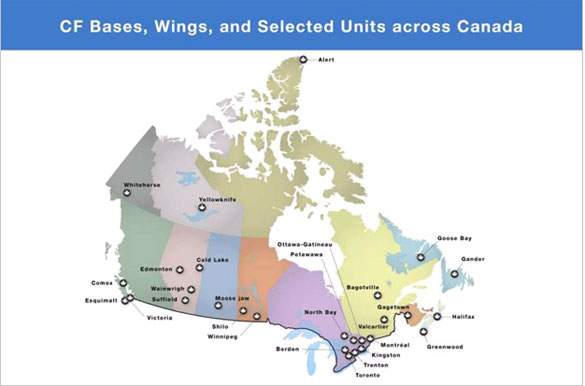
A complete listing of CF installations including bases, wings, stations and support units in Canada is available in Section III: Supplementary Information - Other Items of Interest.
| Departmental Spending ($ thousands) |
|||||
|---|---|---|---|---|---|
| 2007-08 | 2008-09 | 2009-10 | |||
| Actual Spending | Actual Spending | Main Estimates | Planned Spending | Total Authorities | Actual Spending |
| 17,524,049 | 19,184,852 | 19,239,461 | 20,993,001 | 21,045,387 | 19,855,670 |
In 2009-10, the Main Estimates were increased through Supplementary Estimates and allotments from Treasury Board by $1,805.9 million. The difference of $1,189.7 million between the total authorities and the actual spending is attributed primarily to $564.5 million related to capital projects that will be returned to the Department in future years, in accordance with the specific project cash flow schedules; $410 million of operating budget carry forward; $123.4 million in residual lapses which are not available to the Department in future years, $50.4 million in identified lapses related to security at the G8/G20 summits, 2010 Olympics and the response to the earthquake in Haiti, and $28.5 million related to 2010 Olympic Security funding for which the Department plans to seek the authorities required to have the funding returned in 2010-2011.
The total spending difference of $670.8 million between fiscal years 2008-09 and 2009-10 is attributed to an increase of $432.4 million for military and civilian pay and allowances; $157.6 million for professional and other services - primarily in support of operations; $135.8 million net increase for construction and acquisition of land and equipment; $181.4 million net increase across other categories of departmental expenditures, offset by a $162.6 million decrease resulting from a decline in fuel prices in 2009-10; and $73.8 million decrease in travel and transportation expenditures.
Figure: Spending for fiscal year 2009-10 by Program Activity
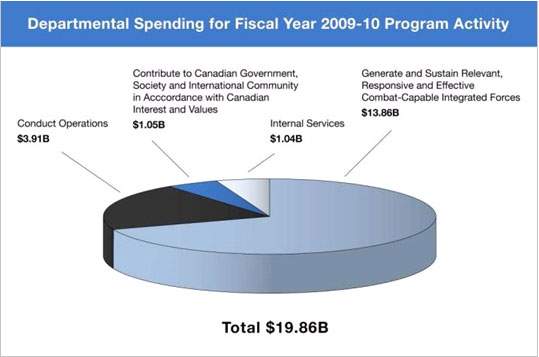
Figure: Financial Spending Trend
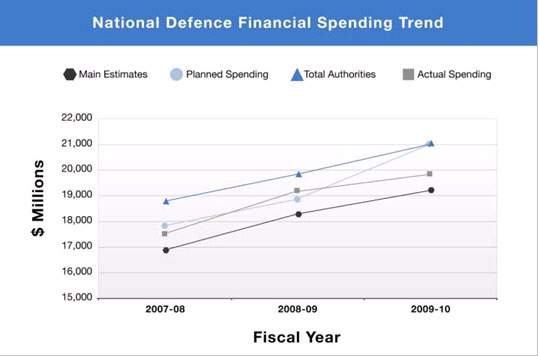
Notes - The following briefly explains the timing of the information provided in the Financial Spending Trend chart above:
- The "Main Estimates" figure is submitted in December, prior to the start of a new fiscal year. It includes the known approved level of funding for the Department as of October.
- "Planned Spending" provides an update of the Main Estimates information on additional funding approved between October and February, as well as expected funding to be approved in the new fiscal year for which Treasury Board Secretariat has approved disclosure.
- "Total Authorities" represent the final authority as shown in the Public Accounts. It represents the final level of approved funding.
- The "Actual Spending", also found in the Public Accounts, represents the final spending on a cash basis.
Voted and Statutory Items
This table explains how Parliament votes resources to Defence in a standardized fashion. It reflects the changes made throughout the fiscal year to funding levels via Supplementary Estimates, allotments from the Treasury Board, and reallocations resulting from changing priorities and operational pressures. Also, it reflects the actual spending for those votes for the current and past two fiscal years.
| Vote (1, 5, 10) or Statutory Item (S) | Truncated Vote or Statutory Wording | ($ Thousands) | ||||
|---|---|---|---|---|---|---|
| 2007-08 | 2008-09 | 2009-10s | ||||
| Actual Spending | Actual Spending | Main Estimates | Total Authorities | Actual Spending | ||
| 1 | Operating expenditures | 12,812,314 | 14,283,787 | 13,460,216 | 15,204,236 | 14,792,353 |
| 5 | Capital expenditures | 3,199,760 | 3,270,903 | 4,272,890 | 4,108,136 | 3,343,432 |
| 10 | Grants and contributions | 168,793 | 191,834 | 223,498 | 232,815 | 229,851 |
| (S) | Minister of National Defence salary and motor car allowance | 74 | 77 | 78 | 78 | 78 |
| (S) | Payments under the Supplementary Retirement Benefits Act | 6,079 | 5,459 | 6,079 | 5,006 | 5,006 |
| (S) | Payments under Parts I-IV of the Defence Services Pension Continuation Act (R.S., 1970 c. D-3) | 1,319 | 1,159 | 1,319 | 1,054 | 1,054 |
| (S) | Payments to dependants of certain members of the Royal Canadian Air Force killed while serving as instructors under the British Commonwealth Air Training Plan (Appropriation Act No. 4, 1968) | 80 | 82 | 84 | 70 | 70 |
| (S) | Contributions to employee benefit plans - Members of the Military | 1,056,614 | 1,106,655 | 971,634 | 1,131,130 | 1,131,130 |
| (S) | Contributions to employee benefit plans | 269,730 | 292,857 | 303,664 | 342,801 | 342,801 |
| (S) | Spending of proceeds from the disposal of surplus Crown assets | 9,242 | 31,998 | N/A | 20,049 | 9,883 |
| (S) | Collection Agency Fees | 44 | 40 | N/A | 12 | 12 |
| Total Department | 17,524,049 | 19,184,852 | 19,239,461 | 21,045,387 | 19,855,670 | |
* Due to rounding, figures may not add up to totals shown.
The Canada First Defence Strategy
To help Defence carry out its roles and responsibilities, the Canada First Defence Strategy (CFDS), released in May 2008, ensures that Canada maintains a first-class, modern military that is well trained, equipped and prepared to meet the challenges of the evolving security environment.
To accomplish this, the CFDS provides a 20-year roadmap to rebuild and modernize the CF with stable and predictable funding that permits long-term planning and investment in four Defence capability areas or pillars:
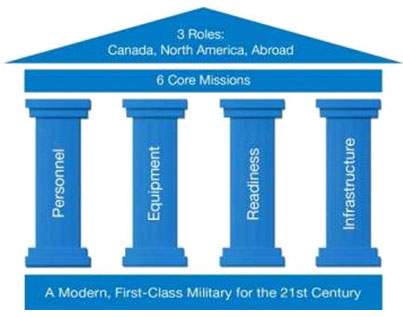
- Personnel: Expand the CF to a total strength of 100,000 (Regular 70,000/Reserve 30,000) by fiscal year 2027-28;
- Equipment: Renew the CF's core equipment platforms;
- Readiness: Maximize personnel training and equipment availability; and
- Infrastructure: Improve the overall condition of Defence infrastructure over the long term.
The CFDS articulates the broad strategic vision for Defence aligned with the level of ambition identified by the Government and outlines six core CF missions in domestic, continental and international contexts:
- Conduct daily domestic and continental operations, including in the Arctic and through the North American Aerospace Defense Command (NORAD);
- Support a major international event in Canada such as the G8, G20 and North American Leaders' Summits;
- Respond to a major terrorist attack;
- Support civilian authorities during a crisis in Canada such as a natural disaster;
- Lead and/or conduct a major international operation for an extended period; and
- Deploy forces in response to crises elsewhere in the world for shorter periods.
For further information, please visit the Canada First Defence Strategy website.
The Defence Priorities
The Defence Priorities focus on the Government's expectations for Defence and highlight the activities essential to achieve excellence in our operations and management. They are also informed by the key corporate risks to which resources were directed to address gaps in capability or capacity. The Defence Priorities articulated in RPP 2009-10 were to:
- Achieve Operational and Mission Success in Afghanistan;
- Support the 2010 Winter Olympics
- Align Defence Activities with Key Government Priorities
- Build the Defence Team
- Build Excellence in Defence Management
Detailed information regarding the contribution of Defence Priorities to the PAA Strategic Outcomes is located in Section III - Supplementary Information - Other Items of Interest.
Defence Planning and Performance Reporting Framework
The following diagram illustrates the alignment of Defence's PAA, Risks and Priorities to the CFDS. This framework forms the basis for communicating Defence's performance story throughout this report.
Figure: Defence Planning and Performance Reporting Framework
